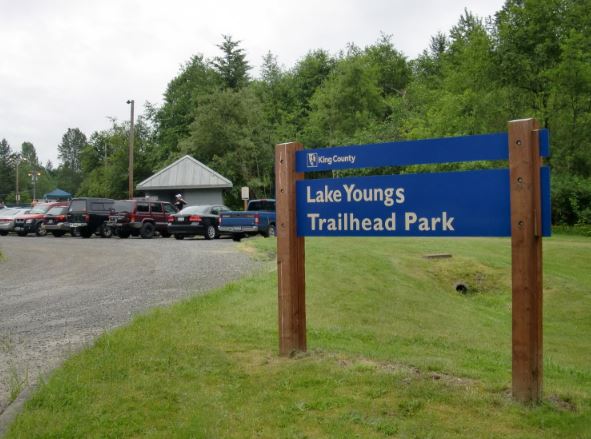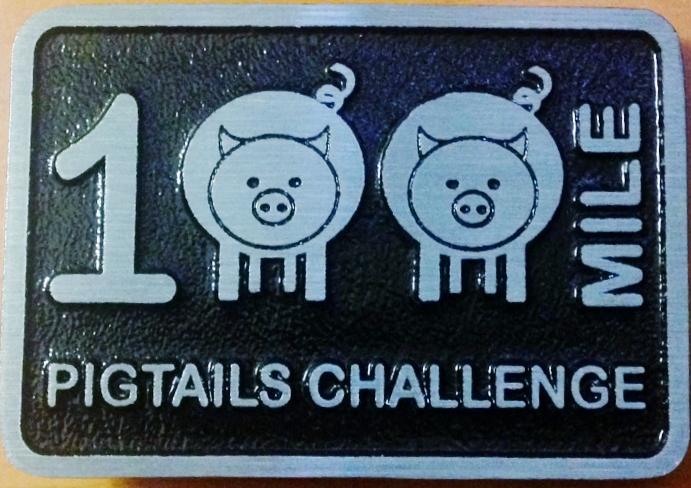I returned for the third time to run the Pigtails Challenge, a lesser-known ultra, near Seattle, Washington. There were five distances, 50K, 100K, 100 miles, 150 miles, and 200 miles. I ran the 150 in 2014 and finished the 100-mile race last year. Each time I had a great first 100-mile time of around 21 hours so I looked forward to try again.
The Pigtails Challenge is held at the Lake Youngs watershed in Renton, Washington, which is only about 15 miles from where I grew up and went to high school. The 9.4-mile loop trail runs around the perimeter of a very protected reservoir that supplies drinking water for Seattle. Along the trail, there is only one place where you can get a glimpse of the lake. The course is very easy to follow because you simply run on the outside of the high fence that guards the property. It always reminds me of the movie, “The Village” where a society lives secretly in the woods behind high walls.
This year I asked permission to run the 100-mile race a day early, when the 150 miles started, so I could get home on Saturday. At the start, I made sure the 150-mile runners knew I wasn’t their competition. I would need to do a 6-mile out-and-back that they wouldn’t have to do and I didn’t want to confuse them. From the start at 6:00 a.m., I took the lead and started my long run on the familiar course. In my mind I break down the course into three sections. First, going clockwise is “the zigzags” which zigzags back and forth near some homes. Second is “the forest maze” which is nice and shady but confuses my tired mind and I get mixed up where I am on the course. Lastly is the “roller-coaster,” a long two-mile stretch by a busy road that goes up and down making it tough on tired legs.
I was pretty concerned how I would do this year. My training the past month had been pathetic as I skipped so many days of training trying to finish up my online book “Swift Endurance Legends.” I had spent many very late nights researching and writing and hardly any running. I was hopeful that rest would compensate for missing training.

My early miles went well, cranking out nine-minute miles for the first four miles. After I made my turnaround for the six-mile out and back, I saw that I was already ahead of the leading 150-mile runner by almost a mile. I would quickly stretch that to four miles, so I had to deal without the help of someone pushing me. Another difference this year was the lack of cool rain. I thrive in cool rain during the day. This year, I would face the heat, nearly 80 degrees.
I finished the six-mile out-and-back in 55 minutes, and just continued on to chase the other runners now several miles ahead on the loop. There were also 200-mile runners out there who had been going for more than 24 hours. They were all moving pretty slowly at that point.
My next loop went well, pretty much according to plan. I reached mile 15.4 at 2:32, just four minutes off my pace for the previous year when I finished in 21:05. After a quick four-minute stop refilling I was on my way to run the loop in the opposite direction. After that loop, I was at mile 24.8. My 4:18 split time was ten minutes slower than 2016. I hit the marathon mark at about 4:30. I consider this as a pretty fast course but this year it seemed like new gravel was put down in sections to slow things down a bit and the 750 feet of hills each loops seemed a lot tougher than I remembered. The heat arrived at about 10: a.m. and did my best to start cooling myself down with water. I finished my third loop nearly a half hour behind last year’s pace. I was already consigned to the reality that I would not be able to break 21 hours this year. With that thought, I stopped for a long bathroom break to solve bad discomfort, with a long 17-minute stop. But it was worth it because my next lap was much better.
During loop 5, I passed the 50-mile mark at about ten hours, a discouraging slow time during the hottest time of the day. The heat was oppressive in certain sun-exposed sections, but the shady forest sections were periods of temporary recovery. I maintained a four-mile lead on the 150-mile leader who was slowing down as much as I was. Last year my slowest of all my loops was 2:16, but this year from loop 4 on, I went slower than 2:20. After loop 5, at mile 53, I knew I was in trouble. I had been hydrating well, but my body temperature was just too high. I was starting to suffer and no longer was having fun. So, I made the right choice. I decided to stop pushing so hard, cool down in my air-conditioned car, eat well, and wait a little longer us the sun descended. After a 21-minute stop I felt so much better and enjoyed running again.
With the long day-time this far north, I wouldn’t have to turn on my flashlight until nearly 10 p.m. The first year, I put in 82 miles before turning on the light. Last year, I covered 78 miles. This year the light came on at mile 71. At about that point, I could tell that my recently lack of training had caught up to me. I felt like I usually did at the finish of 100 miles, but I still had 29 more miles to go. It was rough painful. During the short night I only traveled about 20 miles. Loop nine, miles 81.2-90.6 was the roughest because of severe drowsiness. I stopped during the loop to lie down three times on soft weeds to rest my eyes and decrease my respiration. That 9.4-mile loop took 3:27 including all of the stops. All the other runners were even going more slowly. I was 6-18 miles ahead of all the other runners still out there. Most of the 200-mile runners had disappeared during the night.
I longed for the sun to return, to help bring some energy back to my system. The sky started to brighten up during my final loop. I knew that the 100-milers would start at 6 a.m. I was doing a counter-clockwise loop and they would be coming toward me. I had fun trying to predict exactly when I would see the first runner and predicted exactly right, when I had three miles to go. It seemed like most of them knew I was finishing and said kind words. That last 20 miles had been rough and I was just glad to get it over with. I finished in 26:11:29, more than five hours slower than last year. But my 100-mile finish #92 was in the books, also my 6th for the year. On the bright side, I came away without injury and with only one small blister that I didn’t even notice.
I went back to my motel room after a couple hours of nice rest went and snoozed at the airport, arriving back home by the evening.






